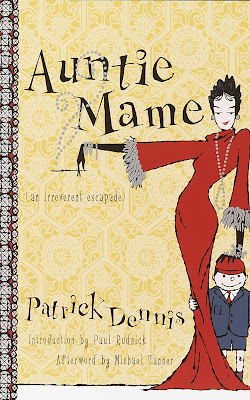by Rich Watson
The 1955 novel Auntie Mame: An Irreverent Escapade by Patrick Dennis sold over two million copies in its first print run, spent five weeks atop the New York Times bestseller chart, and inspired plays, stage musicals and films. The character became one of the most iconic literary women of the twentieth century.
She was probably based on the author’s real-life aunt. The New York neighborhood she inhabited and its unique world, though, was and is all too real.
About Patrick Dennis
Born Edward Everett Tanner III, Dennis also wrote under the pen name Virginia Rowans. (Though he had a wife and two children, he was bisexual.) Mame was his first book written as Dennis. It made him a millionaire.
In the book, he is the ten-year-old ward of his aunt, Mame Dennis. He tells her tale: a woman who lives an extravagant lifestyle while keeping her nephew in tow:
Auntie Mame’s days were spent in a perpetual whirl of shopping, entertaining, going to other people’s parties, being fitted for the outlandish clothes of the day—and hers were even more so—going to the theater and to the little experimental plays that opened and shut like clams all over New York, being taken to dinner by a series of intellectual gentlemen, and traipsing through galleries of incomprehensible pictures and statues. But with all of her hectic, empty life, she still had plenty of time to devote to me.
In 1956, he had two more books on the charts at the same time as Mame. Two years later he wrote a sequel, Around the World with Auntie Mame.
Other works of his were adapted for stage and television.
Dennis died in 1976 at age 55. Mame was his greatest success, a book inspired by his aunt, Marion Tanner.
About Marion Tanner
Tanner died in 1985 at 94. Like Mame, she was originally from Buffalo, attended Smith College—she got her masters in sociology from NYU—worked in Macy’s and acted in plays. She volunteered at a children’s center and doted after kids from broken homes. She even taught ice hockey.
She said she was the real Mame, only “much nicer.” Dennis, however, said his book was not an autobiography.
Tanner and her husband lived at 72 Bank Street in Greenwich Village. (Mame lived on Washington Square.) Artists, writers and other “Bohemian types,” in her words, hung out at her place during the twenties. Later, after the success of Mame, she took in derelicts, bag ladies and other unfortunates. Dennis tried to get her to stop, but she wouldn’t. By 1964 the house was sold when she couldn’t keep up the payments.
Aunt and nephew had a falling out. He denied Mame was based solely on her. After he died, though, she said she believed he loved her, regardless.
Tanner’s lifestyle reflected the neighborhood in which she lived.
Greenwich Village: the recent and distant past
During the eighties, in high school, I attended an afterschool art class at Cooper Union, in the Village. I immersed myself in the neighborhood’s boutiques, cafes, and denizens. Washington Square Park was (and still is) where small concerts, art exhibitions and other performances took place on practically a daily basis. After some time, I’d recognize its regulars.
On Christopher Street, I met a Patti Smith-like musician who wrote original material. At one point she let me record in the studio with her, playing keyboard. I met a different musician in college, on whom I had a crush. She lived in the West Village, played her guitar in subway stations and aspired to be an actress. In my thirties I fell for an artist from the East Village. I worked there for a year. One of my dearest friends, a singer, also lives there.
The Village, to me, means art, both visual and performing art. As much as in Queens, I came of age there, maybe more so.
It began as the site of a prison in the late eighteenth century, far outside the familiar environs. In 1907 it had the nation’s first night court, which meant it drew people from the fringes of society, especially prostitutes, lesbians and women of color. They’d be paraded before the public as a morality warning. The Women’s House of Detention was located on Sixth Avenue and Tenth Street, near Greenwich Avenue. (It’s now the site of a library.)
A homosexual subculture grew. The novel Bachelor Girl details how gay men interacted with each other during this period.
These were the kinds of people to whom Tanner, and Mame, catered.
Sometimes I wish the Village still looked to me like it did when I was seventeen. It has, however, newer restaurants, cafes and bookshops I frequent. And Washington Square will remain Washington Square.
Don’t see that changing.
———
News: Written Tales will run my short story, “Their Cheating Hearts,” in two days, on March 14. It’s the first published one set in my fictitious city of Thurber—actually, more like just outside. It has a supernatural, Twilight Zone-type angle to it.
———
Also in 1955:
- The third Lord of the Rings book, The Return of the King, by JRR Tolkien, is published.
- Lolita, by Vladimir Nabokov, is published, in France.
- The Talented Mr. Ripley, by Patricia Highsmith, is published.
- Samuel Beckett’s play Waiting for Godot is translated into English.
- James Baldwin publishes Notes of a Native Son, his collection of essays.
———
Did you read Auntie Mame? Leave a comment and let me know!
Share if you liked this post
⬇️


No comments:
Post a Comment